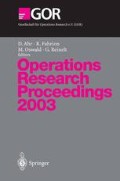Abstract
In [3] QP-problems with strict convex objective functions / were investigated in order to detect constraints that are not active at the optimal point x*. It turned out, that simple calculations performed in parallel with an QP-solver allow a decision to delete restrictions from the problem. This might shrink down the problem size during the optimization procedure. These sufficient conditions for non activity could be generalized to the positive semi-definite case (see [4]).
In the present paper it is shown that the techniques presented in [3] allow to get additional possibilities for a deletion of superfluous constraints. For this, the optimal point x 0 of the unrestricted QP-problem is suitably disturbed within some special set M(f(x*). This set is unknown in advance but a subset A(x 0) can algorithmically be generated. It is also proved, that x* is a limit point in A(x 0).
Access this chapter
Tax calculation will be finalised at checkout
Purchases are for personal use only
Preview
Unable to display preview. Download preview PDF.
References
Goldfarb, D., Liu, S. (1991) An O(n 3 L) primal interior point algorithm for convex quadratic programming. Math. Prog. Ser.A, 3, 325–340
Mehrotra, S., Sun, J. (1990) An algorithm for convex quadratic programming that requires O(n 3,5 L) arithmetic operations. Math. Oper. Res. 15, No.2, 342–363.
Recht, P. (2001) Identifying non-active restrictions in convex quadratic programming. Math. Meth. of OR 54, 53–61.
Recht, P. (2003) Redundancies in positive semidefinite quadratic programming. JOTA. 119, No. 3, 553–564.
Author information
Authors and Affiliations
Editor information
Editors and Affiliations
Rights and permissions
Copyright information
© 2004 Springer-Verlag Berlin Heidelberg
About this paper
Cite this paper
Recht, P. (2004). Detecting Superfluous Constraints in Quadratic Programming by Varying the Optimal Point of the Unrestricted Problem. In: Ahr, D., Fahrion, R., Oswald, M., Reinelt, G. (eds) Operations Research Proceedings 2003. Operations Research Proceedings, vol 2003. Springer, Berlin, Heidelberg. https://doi.org/10.1007/978-3-642-17022-5_38
Download citation
DOI: https://doi.org/10.1007/978-3-642-17022-5_38
Publisher Name: Springer, Berlin, Heidelberg
Print ISBN: 978-3-540-21445-8
Online ISBN: 978-3-642-17022-5
eBook Packages: Springer Book Archive

